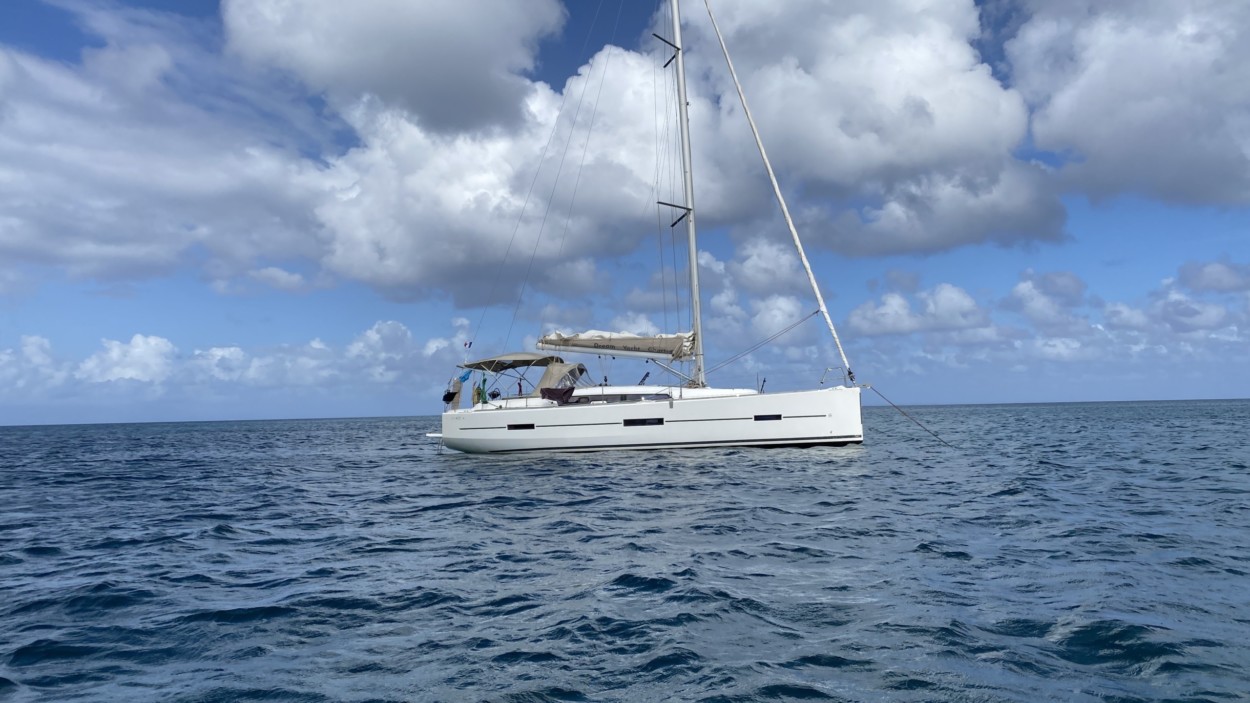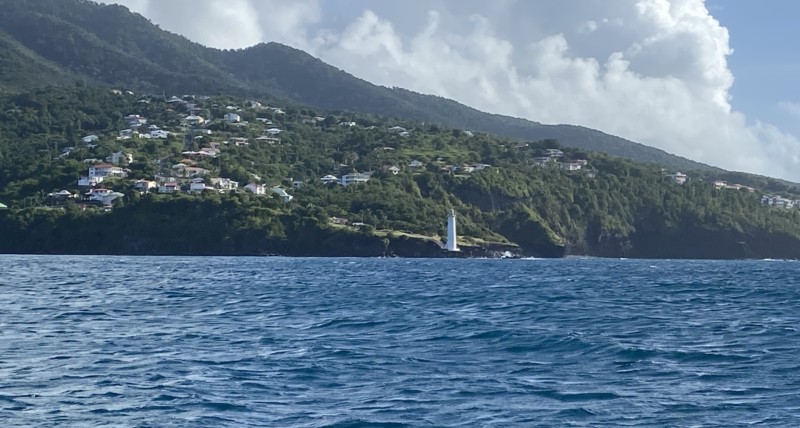A number of people have asked us what it’s like to live on a sailboat for an extended period.
When you think about it, having two adults and two teenagers cohabitating a 40 foot space does bring up issues like personal space!
That been said, Aoibhin and Fiachra, our teenage kids have grown up on boats and are very used to sharing very modest quarters on our 32.5 footer “Pepperbox” so when we took possession of Bermuda, the 40 footer we are sailing on in the Caribbean, everyone, Mandy and I included went – Wow so much space!
A little bit about Bermuda
I wrote the following description when we first took the boat:
She’s a Dufour 412 GL. At 12.7 Metres long (A little over 40 feet) she is a fast comfortable boat and well equipped for offshore sailing. Down below we have a 3 cabin layout. The kids each get their own space in the aft of the boat and Mandy and I have a cabin in the bow. It has two heads (bathrooms). Our 3 first world challenges are Water, power and Wifi access. We carry 380 Litres of water and power is generated via our engine and solar panels. WIFI is via Digicel wherever we can get signal. For safety and tracking purposes, we carry a Garmin inreach tracker that connects via satellite signal.
What else would I add now?
I come from a racing background and I grew up with boats where everything was optimised for speed. If there was even a slight resistance where a rope went through a pulley block, it was out with the WD40 and silicon to make sure the bearings were moving freely. In cruising boats I think more attention is placed on the accommodation and the cockpit layout where you spend most of your time. Often the sail plan is an after thought.
As a family we all enjoy the sailing part and can actually get quite competitive on occasion🙂 So its important to us that the boat sails well. In fairness to Bermuda, although she is a cruising boat, first and foremost, she sails well. Add to this the fact that you are typically sailing in moderate to fresh winds, with the wind mostly coming from the beam (The Antilles island chain pretty much run North to South so you are for the most part reaching up and down with the wind coming from the side so there is little tacking over and back to get to your destination) and the result was some very fast passages where the speed has hitting 9 knots – all very acceptable for a sailboat.
We also tested the boat in some challenging conditions, particularly in the Guadeloupe to Dominica and Dominica to Martinique legs where we had 25 knots of sustained winds with gusts up to 30 and some pretty big seas and the boat performed well and handled the seas well.
I think the sail plan is good and the reefing system worked well on the mainsail – This allowed us to shorten sail when we saw wind and rain squalls or pulses coming through.
Any gripes?
My only gripe on the sail plan (and I think this may be the case with a lot of cruising boats) is that rope pulling involved quite a bit of effort. We pretty much had to use the winch for everything. When the wind piped up I was very happy that there were 4 competent sailors onboard. In many cruising scenarios it’s often just a couple who are managing everything.
I mentioned that our first world problems were water, power and WiFi.
Regarding water, there was an initial “adjustment period” where we needed to adapt to using less water. We carry 380 litres in 2 tanks. This runs the taps in the heads, galley and the outside shower. Refilling with water is a hassle and needs to be planned. There are very few marinas in the Caribbean and without a marina the only way to get water is to fill 25 litre jerry cans, load them onto the dinghy and then decant them into the tanks – all very laborious. We decided we would opt to be frugal with our water consumption and plan our marina visits to refill (We also needed to refill diesel and would try to coordinate this at the same time). We managed to get our water consumption down to 30 litres per day. This gave us approximately 12-14 days of water from full tanks. We bought jerry cans for water and diesel so we also carried an emergency supply.
For context the average American shower uses 17.2 gallons (65.1 liters) and lasts for 8.2 minutes at average flow rate of 2.1 gallons per minute (gpm) (7.9 lpm). There are four of us on board – Based on these calculations (and assuming we showered every day) we would need 260 litres a day just for showers and refill every second day. Obviously not an option!
So how did we get our consumption down to 30 litres? The trick is to jump in for a swim and then soap up using a bucket of salt water. Dive in again to wash off the suds and then finally a 10 second shower to wash off the salt.
We also had a salt water tap in the galley – this is a god send and a feature more commonly seen on older boats – My dad’s Golden shamrock (30 footer) had one of these. We used the salt water for the washing up, filling the saucepan to boil potatoes etc. We could then use a minimal amount of fresh water to rinse dishes and cutlery (and stop them rusting🙂 )
I should point out that this 30 litres did not include our drinking water. Technically the water quality in the Caribbean islands is pretty good but the marina water has a lot of chemicals in it. It won’t kill you but my crew insisted on fresh water so we did need to provision for this. We initially stored our drinking water in 1.5 litre bottles and went through approximately 6 bottles a day. So ten days worth of water required us to carry 60 1.5 litre bottles. To reduce plastic we switched to 5 litre drums and then refilled the 1.5 litre bottles which we could store in the fridge. Transporting water was always a challenge and we tried to coordinate when we found a store next to a dinghy dock.
For long term cruising I would really recommend a water maker. They have really improved in recent years and the costs have come right down. However its not reasonable to expect this on a charter boat where most people are only sailing for two weeks at a time.
Power was our next challenge. Our fridge is absolutely huge and required a LOT of battery power to run it. Considering we were rarely in a marina we need to be self sufficient and our power primarily came from our Diesel engine which recharged our batteries. However we needed to run the engine for at least 4 hours a day to keep the 12 V batteries in charge. We carried one dedicated battery for starting the engine and then 3 service batteries for running boat appliances. We ran an inverter which allowed us to change mobile phones, iPads, laptop, navigation equipment like our Iridium tracker, GoPro camera. As back up I had two mobile 2000 AD battery packs which were brilliant.
WIFI – As well as entertainment we relied on WiFi to get weather forecasts although we could request a marine forecast on our iridium tracker which works on a satellite communications plan. We could use our Ireland SIM cards in Guadeloupe and Martinique as this is technically Europe (Part of France). However for the other countries we used a digicel SIM card with a local number. We found coverage to be quite patchy in Antigua and Saint Lucia (Max 3G) but excellent in Saint Vincent and the Grenadines and in Grenada where we had LTE coverage which I understand is the US equivalent of 4G.
Master cabin in the bow. In some ways it was lovely being up in the bow with the forward hatch open and the fresh trade winds streaming though keeping us nice and cool at night (25 degrees Celsius at night). However whenever we were in an anchorage with a roll, the roll was definitely accentuated in the forward cabin. We also heard all the groans and squeaks from the anchor and I often held my breath when the big squalls came through just waiting for the anchor to drag. We started using an app called Anchor pro which allowed us to set anchor based on GPS position and set a radius (eg 30 metres). Once the boat drifted outside this radius the alarm would go off. This did happen a couple of times and its not the nicest way to wake up :). We also reduced the anchor noise by setting up a “snubber” for the anchor. We attached a shackle to the chain and then ran a rope through the shackle on a bridle. This stopped the shock loads or snatching when the the boat suddenly changed direction and the elasticity in the rope absorbed some of the shock loads. This also had the benefit where we didn’t have as much noise from the anchor chain.
These points are more considerations for longer term cruising and don’t reflect any real issues with the boat.
Overall we thought she was very comfortable, sailed well and was safe and fast offshore.
Enjoy the tour in the video below and hit me up with any questions in the comments and I’ll try to answer.
Talk soon.
Follow our boat Bermuda on https://www.noforeignland.com/boat/4967280230268928




